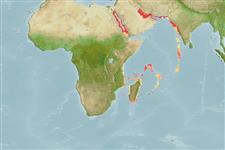Issue
This species is a synonym of Equulites berbis (Valenciennes 1835) according to Suzuki & Kimura, 2023 (Ref. 130900). This summary page will be deleted.
Environment: milieu / climate zone / rango de profundidad / distribution range
Ecología
marino demersal; rango de profundidad 10 - 77 m (Ref. 122739). Tropical; 30°N - 16°N, 32°E - 59°E
Western Indian Ocean: endemic to northern Red Sea. Lessepsian migrant to Mediterranean Sea.
Tamaño / Peso / Age
Madurez: Lm ? range ? - ? cm
Max length : 13.4 cm SL macho / no sexado; (Ref. 120651)
Short description
Claves de identificación | Morfología | Morfometría
Espinas dorsales (total) : 7; Radios blandos dorsales (total) : 15 - 16; Espinas anales: 3; Radios blandos anales: 15 - 16.
Body shape (shape guide): fusiform / normal; Cross section: compressed.
Inhabits coastal waters and feeds on bottom invertebrates. Reproduces in the summer months (Ref. 6757).
Life cycle and mating behavior
Madurez | Reproducción | Puesta | Huevos | Fecundidad | Larva
Roux, C., 1986. Leiognathidae. p. 856-857. In P.J.P. Whitehead, M.-L. Bauchot, J.-C. Hureau, J. Nielsen and E. Tortonese (eds.) Fishes of the north-eastern Atlantic and the Mediterranean. UNESCO, Paris. Vol. 2. (Ref. 6757)
IUCN Red List Status (Ref. 130435: Version 2024-2)
Threat to humans
Harmless
Human uses
Pesquerías: comercial
Herramientas
Special reports
Download XML
Fuentes de Internet
Estimates based on models
Preferred temperature (Referencia
123201): 24.5 - 29.3, mean 26.5 °C (based on 82 cells).
Phylogenetic diversity index (Referencia
82804): PD
50 = 0.5002 [Uniqueness, from 0.5 = low to 2.0 = high].
Bayesian length-weight: a=0.01122 (0.00842 - 0.01496), b=3.09 (3.03 - 3.15), in cm total length, based on LWR estimates for this species (Ref.
93245).
Nivel trófico (Referencia
69278): 3.5 ±0.37 se; based on food items.
Resiliencia (Referencia
120179): Medio, población duplicada en un tiempo mínimo de 1.4-4.4 años (Preliminary K or Fecundity.).
Fishing Vulnerability (Ref.
59153): Low vulnerability (10 of 100).
🛈
